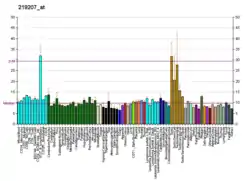EDC3
Enhancer of mRNA-decapping protein 3 is a protein that in humans is encoded by the EDC3 gene.[5][6][7]
EDC3 is associated with an mRNA-decapping complex required for removal of the 5-prime cap from mRNA prior to its degradation from the 5-prime end (Fenger-Gron et al., 2005).[supplied by OMIM][7]
References
- GRCh38: Ensembl release 89: ENSG00000179151 - Ensembl, May 2017
- GRCm38: Ensembl release 89: ENSMUSG00000038957 - Ensembl, May 2017
- "Human PubMed Reference:". National Center for Biotechnology Information, U.S. National Library of Medicine.
- "Mouse PubMed Reference:". National Center for Biotechnology Information, U.S. National Library of Medicine.
- Albrecht M, Lengauer T (Jun 2004). "Novel Sm-like proteins with long C-terminal tails and associated methyltransferases". FEBS Lett. 569 (1–3): 18–26. doi:10.1016/j.febslet.2004.03.126. PMID 15225602.
- Rudolph C, Sigruener A, Hartmann A, Orso E, Bals-Pratsch M, Gronwald W, Seifert B, Kalbitzer HR, Verdorfer I, Luetjens CM, Ortmann O, Bornstein SR, Schmitz G (May 2007). "ApoA-I-binding protein (AI-BP) and its homologues hYjeF_N2 and hYjeF_N3 comprise the YjeF_N domain protein family in humans with a role in spermiogenesis and oogenesis". Horm Metab Res. 39 (5): 322–35. doi:10.1055/s-2007-977699. PMID 17533573.
- "Entrez Gene: EDC3 enhancer of mRNA decapping 3 homolog (S. cerevisiae)".
Further reading
- Maruyama K, Sugano S (1994). "Oligo-capping: a simple method to replace the cap structure of eukaryotic mRNAs with oligoribonucleotides". Gene. 138 (1–2): 171–4. doi:10.1016/0378-1119(94)90802-8. PMID 8125298.
- Suzuki Y, Yoshitomo-Nakagawa K, Maruyama K, et al. (1997). "Construction and characterization of a full length-enriched and a 5'-end-enriched cDNA library". Gene. 200 (1–2): 149–56. doi:10.1016/S0378-1119(97)00411-3. PMID 9373149.
- Strausberg RL, Feingold EA, Grouse LH, et al. (2003). "Generation and initial analysis of more than 15,000 full-length human and mouse cDNA sequences". Proc. Natl. Acad. Sci. U.S.A. 99 (26): 16899–903. doi:10.1073/pnas.242603899. PMC 139241. PMID 12477932.
- Ota T, Suzuki Y, Nishikawa T, et al. (2004). "Complete sequencing and characterization of 21,243 full-length human cDNAs". Nat. Genet. 36 (1): 40–5. doi:10.1038/ng1285. PMID 14702039.
- Jin J, Smith FD, Stark C, et al. (2004). "Proteomic, functional, and domain-based analysis of in vivo 14-3-3 binding proteins involved in cytoskeletal regulation and cellular organization". Curr. Biol. 14 (16): 1436–50. doi:10.1016/j.cub.2004.07.051. PMID 15324660.
- Gerhard DS, Wagner L, Feingold EA, et al. (2004). "The Status, Quality, and Expansion of the NIH Full-Length cDNA Project: The Mammalian Gene Collection (MGC)". Genome Res. 14 (10B): 2121–7. doi:10.1101/gr.2596504. PMC 528928. PMID 15489334.
- Wan D, Gong Y, Qin W, et al. (2004). "Large-scale cDNA transfection screening for genes related to cancer development and progression". Proc. Natl. Acad. Sci. U.S.A. 101 (44): 15724–9. doi:10.1073/pnas.0404089101. PMC 524842. PMID 15498874.
- Fenger-Grøn M, Fillman C, Norrild B, Lykke-Andersen J (2006). "Multiple processing body factors and the ARE binding protein TTP activate mRNA decapping". Mol. Cell. 20 (6): 905–15. doi:10.1016/j.molcel.2005.10.031. PMID 16364915.
- Beausoleil SA, Villén J, Gerber SA, et al. (2006). "A probability-based approach for high-throughput protein phosphorylation analysis and site localization". Nat. Biotechnol. 24 (10): 1285–92. doi:10.1038/nbt1240. PMID 16964243.
- Ewing RM, Chu P, Elisma F, et al. (2007). "Large-scale mapping of human protein–protein interactions by mass spectrometry". Mol. Syst. Biol. 3 (1): 89. doi:10.1038/msb4100134. PMC 1847948. PMID 17353931.
- Tritschler F, Eulalio A, Truffault V, et al. (2007). "A Divergent Sm Fold in EDC3 Proteins Mediates DCP1 Binding and P-Body Targeting". Mol. Cell. Biol. 27 (24): 8600–11. doi:10.1128/MCB.01506-07. PMC 2169425. PMID 17923697.
This article is issued from Wikipedia. The text is licensed under Creative Commons - Attribution - Sharealike. Additional terms may apply for the media files.





